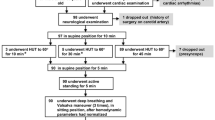Abstract
Active standing test is clinically used to detect inadequate sympathetic nervous system response to the orthostasis. Peripheral arterial tone (PAT) is a recently developed technology whereby sympathetic activity can be measured through monitoring the digit arterial pulsatile volume. We aimed to determine the response of PAT to the orthostasis. The PAT and short-time frequency domain heart rate variability (HRV) were simultaneously measured during a 5.5-min active standing test in volunteers. The endpoints were changes in the PAT and ratio of low frequency to high frequency (LH/HF) before and after the postural changes: sitting→standing→sitting again. The blood pressure (BP) was constant throughout the test while the heart rate increased during standing in 54 participants. The natural logarithm of the mean LF/HF increased in the standing position (sitting, standing, and sitting again, mean±standard deviation, 1.3±1.04, 1.73±1.15, and 1.51±0.94; p=0.006), and the natural logarithm of its peak value was the highest also while standing (2.58±1.19, 3.08±1.2, and 2.85±1.05; p=0.007). The mean PAT (487.5±277.7, 314.5±180.4, and 458.1±244.3; p <0.001) and its nadir value (341.8±204.8, 189.4±119.2, and 264.3±157.6; p <0.001) declined during standing, and reascended after sitting again. The percent change before and after the standing in mean PAT was not correlated with that of the mean LF/HF. In conclusion, the PAT changed independently of and inversely with the LF/HF during the orthostatic test while the BP remained constant, possibly reflecting peripheral vasocontraction needed for the BP homeostasis.







Similar content being viewed by others
References
Finucane C, van Wijnen VK, Fan CW, Soraghan C, Byrne L, Westerhof BE, Freeman R, Fedorowski A, Harms MPM, Wieling W, Kenny R (2019) A practical guide to active stand testing and analysis using continuous beat-to-beat non-invasive blood pressure monitoring. Clin Auton Res 29:427–441
Magder S (2012) Bench-to-bedside review: an approach to hemodynamic monitoring--Guyton at the bedside. Crit Care 16:236
Heart rate variability (1996) Standards of measurement, physiological interpretation, and clinical use. Task Force of the European Society of Cardiology and the North American Society of Pacing and Electrophysiology. Eur Heart J 17:354-81
Tamura Y, Ishikawa J, Fujiwara Y, Tanaka M, Kanazawa N, Chiba Y, Iizuka A, Kaito S, Tanaka J, Sugie M, Nishimura T, Kanemaru A, Shimoji K, Hirano H, Furuta K, Kitamura A, Seino S, Shinkai S, Harada K et al (2018) Prevalence of frailty, cognitive impairment, and sarcopenia in outpatients with cardiometabolic disease in a frailty clinic. BMC Geriatr 18:264
Penzel T, Kesper K, Pinnow I, Becker HF, Vogelmeier C (2004) Peripheral arterial tonometry, oximetry and actigraphy for ambulatory recording of sleep apnea. Physiol Meas 25:1025–1036
Bar A, Pillar G, Dvir I, Sheffy J, Schnall RP, Lavie P (2003) Evaluation of a portable device based on peripheral arterial tone for unattended home sleep studies. Chest 123:695–703
Ernst G (2017) Heart-Rate Variability-More than Heart Beats? Front Public Health 5:240
Pomeranz B, Macaulay RJ, Caudill MA, Kutz I, Adam D, Gordon D, Kilborn KM, Barger AC, Shannon DC, Cohen RJ, Benson H (1985) Assessment of autonomic function in humans by heart rate spectral analysis. Am J Phys 248:H151–H153
Pagani M, Lombardi F, Guzzetti S, Rimoldi O, Furlan R, Pizzinelli P, Sandrone G, Malfatto G, Dell'Orto S, Piccaluga E, Turiel M, Baselli G, Cerutti S, Malliani A (1986) Power spectral analysis of heart rate and arterial pressure variabilities as a marker of sympatho-vagal interaction in man and conscious dog. Circ Res 59:178–193
Ricci F, De Caterina R, Fedorowski A (2015) Orthostatic hypotension: epidemiology, prognosis, and treatment. J Am Coll Cardiol 66:848–860
Mar PL, Raj SR (2018) Orthostatic hypotension for the cardiologist. Curr Opin Cardiol 33:66–72
Magkas N, Tsioufis C, Thomopoulos C, Dilaveris P, Georgiopoulos G, Sanidas E, Papademetriou V, Tousoulis D (2019) Orthostatic hypotension: from pathophysiology to clinical applications and therapeutic considerations. J Clin Hypertens (Greenwich) 21:546–554
Laurent S, Boutouyrie P (2015) The structural factor of hypertension: large and small artery alterations. Circ Res 116:1007–1021
Hayano J, Yuda E (2019) Pitfalls of assessment of autonomic function by heart rate variability. J Physiol Anthropol 38:3
Montano N, Ruscone TG, Porta A, Lombardi F, Pagani M, Malliani A (1994) Power spectrum analysis of heart rate variability to assess the changes in sympathovagal balance during graded orthostatic tilt. Circulation 90:1826–1831
Efremov K, Brisinda D, Venuti A, Iantorno E, Cataldi C, Fioravanti F, Fenici R (2014) Heart rate variability analysis during head-up tilt test predicts nitroglycerine-induced syncope. Open Heart 1:e000063
Pitzalis MV, Mastropasqua F, Massari F, Forleo C, Di Maggio M, Passantino A, Colombo R, Di Biase M, Rizzon P (1996) Short- and long-term reproducibility of time and frequency domain heart rate variability measurements in normal subjects. Cardiovasc Res 32:226–233
Sandercock GR, Bromley PD, Brodie DA (2005) The reliability of short-term measurements of heart rate variability. Int J Cardiol 103:238–247
Nunan D, Sandercock GR, Brodie DA (2010) A quantitative systematic review of normal values for short-term heart rate variability in healthy adults. Pacing Clin Electrophysiol 33:1407–1417
Author information
Authors and Affiliations
Corresponding author
Additional information
Publisher’s note
Springer Nature remains neutral with regard to jurisdictional claims in published maps and institutional affiliations.
Supplementary Information
Rights and permissions
About this article
Cite this article
Okamura, S., Sairaku, A., Tokuyama, T. et al. Peripheral arterial tone during active standing. Pflugers Arch - Eur J Physiol 473, 1939–1946 (2021). https://doi.org/10.1007/s00424-021-02632-0
Received:
Revised:
Accepted:
Published:
Issue Date:
DOI: https://doi.org/10.1007/s00424-021-02632-0





